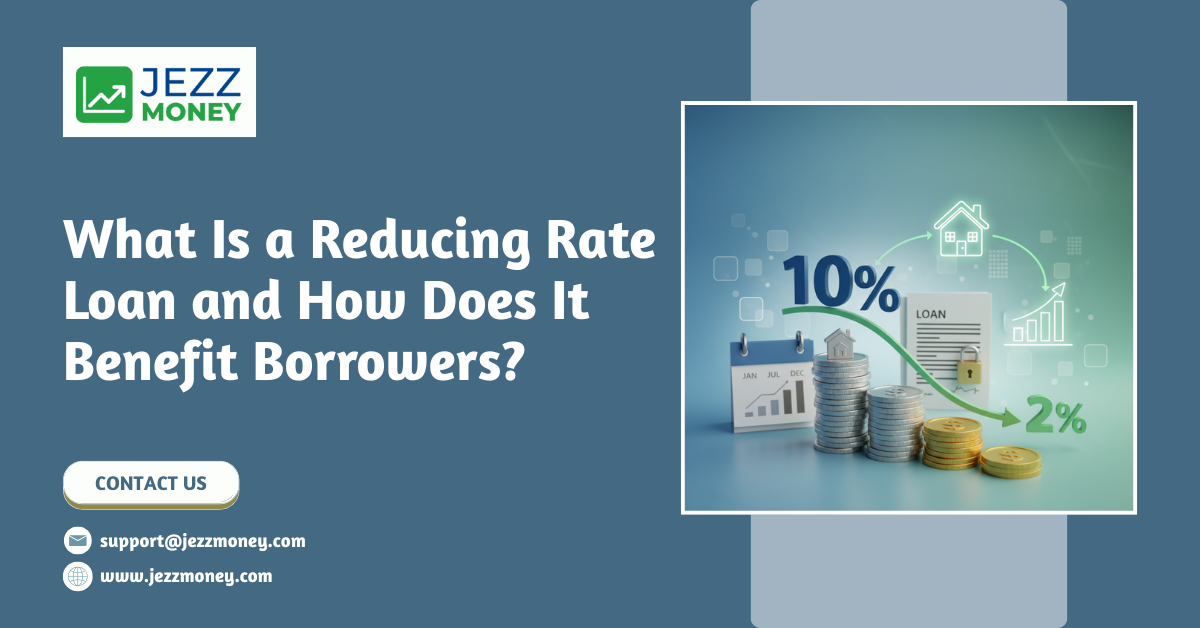What Is a Reducing Rate Loan and How Does It Benefit Borrowers?

Securing a loan can be a crucial financial decision, whether you're planning to expand a business, buy a home, or meet personal needs. One of the most important factors to consider when choosing a loan is the type of interest calculation: flat rate or reducing rate. For many borrowers in India, understanding reducing rate loans and their benefits can lead to major savings and smarter financial planning.
What Is a Reducing Rate Loan?
A reducing rate loan, also called a reducing balance loan or diminishing balance loan, uses a system where interest is always calculated on the outstanding amount of the loan, not the original principal. This means that as you pay off your loan through regular EMIs (equated monthly instalments), the interest is applied only to the remaining principal. Over time, this results in a decreasing interest component within each EMI.
Reducing Rate in Action: A Quick Example
Suppose you take a home loan of ₹10 lakhs at a reducing interest rate of 10% per annum. After your first EMI, if you've paid down the principal by ₹50,000, your next month's interest will be calculated on ₹9,50,000 instead of the original ₹10 lakhs. Each subsequent EMI further lowers the principal, so the interest portion of each EMI keeps reducing.
How is the reduction in interest rate calculated?
The formula for calculating interest in a reducing-rate loan is straightforward:
Interest payable each instalment=Outstanding Principal×Interest Rate (per instalment)Interest payable each instalment=Outstanding Principal×Interest Rate (per instalment)
Each month, after deducting the principal repaid in the previous EMI, only the remaining balance gets charged interest. This differs from the flat interest method, where interest is always charged on the total principal amount for the full loan tenure.
Reducing Rate vs Flat Rate: The Key Differences
| Parameter | Flat Rate Loan | Reducing Rate Loan |
|---|---|---|
| Interest is calculated on | Original loan amount (entire tenure) | Outstanding principal (declines over tenure) |
| Interest paid (overall) | Higher | Lower |
| EMI structure | Same components throughout | Interest part decreases, principal increases |
| Effective cost | Ends up being much higher | Closer to the advertised rate |
| Ideal for | Short-tenure or simple loans | Long-tenure, large-value loans |
Example: For the same loan amount and interest rate (say, 12%), you would pay much less overall interest using a reducing rate loan compared to a flat rate loan.
Major Benefits of Reducing Rate Loans
1. Lower Total Interest Payout
Because interest is always based on the current balance, your total interest paid throughout the loan term is significantly less than with a flat rate loan. This is especially helpful for long-term loans like home loans or education loans.
2. Fairer to the Borrower
Each repayment reduces your interest cost, reflecting your outstanding liability more accurately. Repaying early means even more savings because you stop the interest from accruing on the principal already paid.
3. Budget-Friendly EMIs
While your EMI amount typically stays the same, the portion going towards interest keeps reducing, and the portion applied to principal increases every month. This helps you become debt-free faster and manage your future finances better.
4. Encourages Early Repayment
If you have extra funds and want to prepay a part of your loan, reducing rate loans reward you instantly by lowering your overall interest outlay. Flat rate loans don't offer this benefit, since their interest is already fixed for the entire period.
5. Best for Large or Long-Term Loans
Reducing rate loans shine when dealing with larger borrowings—think home loans, business loans, or substantial personal loans—where even a small percentage saving on interest translates to big rupee savings over the full term.
Are There Any Drawbacks?
Reducing rate loans sometimes appear to have a slightly higher interest rate than flat rate loans. But don’t be misled: their effective cost is almost always lower, considering how the calculation works. The calculations can be a bit more complex, but there are several online tools to help you work out your exact EMIs and interest payout.
When Should You Choose a Reducing Rate Loan?
-
For high-value, long-tenure loans: E.g., home loans, education loans, business loans.
-
If you plan to prepay: Flexible structures reward partial or full early repayment.
-
When transparency matters: Reducing rate loans gives a clear picture of true costs.
Flat rate loans can be considered for short-term needs or small loan amounts, where calculation simplicity matters more than long-term savings.
Practical Tips Before Taking a Reducing Rate Loan
-
Always compare the total repayment amount, not just the interest rate.
-
Use online reducing rate calculators to check your EMI and interest outgo in advance.
-
Ask the lender about prepayment charges if you plan to repay early.
-
Evaluate your repayment capacity and choose a loan tenure that suits your budget.
Conclusion
To sum it up, a reducing rate loan is structured to benefit borrowers by ensuring interest is calculated only on the outstanding principal. Over the life of your loan, this means lower total interest paid, a fairer repayment system, and the chance to become debt-free sooner. Before you commit, make sure you use a reducing rate of interest calculator to understand your potential savings, and if you want to compare it directly, a flat vs reducing rate calculator will help you find the loan type that best fits your needs.
Taking a little time to understand these differences can help you save a substantial sum and choose the most cost-effective loan for your goals.








